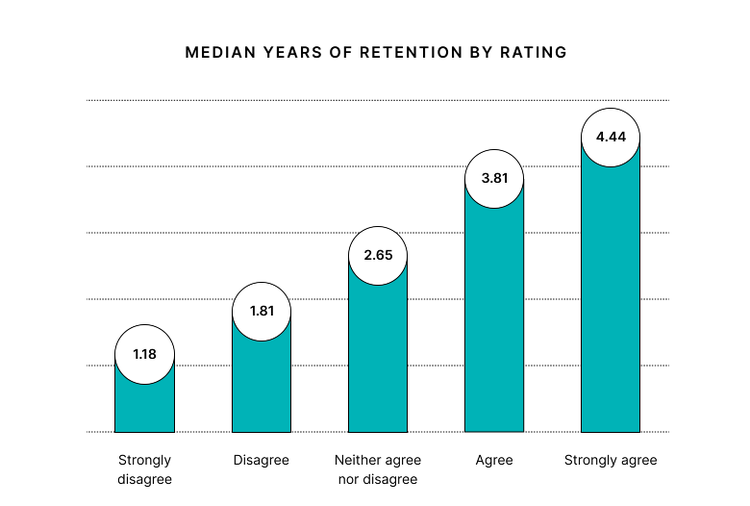
The importance of measuring commitment in employee surveys

Written by

Senior People Scientist, Culture Amp
If you’ve ever wondered, “Is Culture Amp’s commitment engagement item (‘I see myself still working at this company in 2 years’) even relevant?” – we would say you’re not alone. Especially considering the Great Resignation/Great Reshuffling and recent mass layoffs in the tech industry, we understand that it’s natural to question the relevance of measuring employee commitment – particularly in this context.
Despite today’s waxing and waning turnover trends, our People Science and research teams still strongly believe in the importance of measuring commitment in employee surveys. We’ve previously provided insights into the strong correlation between commitment and retention, and our latest study only doubles down on these findings.
In this article, we’ll share our latest research on the relationship between commitment and retention.
Our methodology
We looked at data over the last ten years for 4.05 million employees across 5,712 companies that work with us. Of those 4.05 million employees, 1.4 million left their organizations within that ten year timeframe.
The main question we wanted to answer was: “How long do employees stay after they answer the question, ‘I see myself still working at this company in 2 years’ time?” Read on to find out what we learned.
What we found
Below, we unpack employees’ overall retention projections and analyze differences across Gender, Industry, and Age.
Retention projections
We found that the median years employees stayed with an organization after selecting “strongly disagree” was a mere 1.18 years. Conversely, those who selected “strongly agree” ended up staying with their organizations for a median of 4.44 years.
The specific median periods in which employees stayed with their company after answering the commitment question were:
- 1.18 years from the first time an employee answered “strongly disagree”
- 1.81 years for “disagree”
- 2.65 years for “neither agree nor disagree”
- 3.81 years for “agree”
- 4.44 years for “strongly agree”

Our data also reveals that on average, the likelihood a company will retain an employee for the following two years is:
- 36 - 47% for employees who responded “strongly disagree” or “disagree”
- 57% for employees who responded “neither agree nor disagree”
- 70% for employees who responded favorably – “strongly agree agree” or “agree”
These gaps in two-year retention rates grow even larger by year 3, with only 28% of those who strongly disagreed being retained, compared with 60% of those who strongly agree.
This finding validates the notion that employees will honestly share their commitment intentions when asked, and that these intentions are predictive of their ultimate behavior. Furthermore, the data shows that asking the commitment question will provide your organization with critical insights into retention – even if turnover continues to ebb and flow externally.
Demographic comparisons
Our team also assessed the retention projections for gender, age, and industry and found that the retention trend remained true regardless of demographic group. In other words, our commitment item is still predictive and relevant, even across these different facets.

However, the most interesting comparison distinctions were found between industries. Across the 13 industries we reviewed, we found that those who respond unfavorably to our commitment item typically end up leaving around 2 years or less, regardless of industry.
Where we start to see a larger difference across industries is for those who feel favorably about their commitment. This is unsurprising as the nature of these different industries may play a part in employee commitment. For example:
- It’s unsurprising to see shorter retention for the Hospitality industry (2.59 median years for “strongly agree”) since this workforce is mostly part-time employees or those who view their role as a temporary work arrangement.
- On the opposite end, we have Technology, Science, and Research with the longest retention (7.16 median years for “strongly agree”). This industry is often highly specialized with limited competitors and primarily composed of employees who spent decades refining their expertise in academia. As a result, these employees would prefer to stay at a place longer since fewer companies require their specific skills and knowledge.
The industry comparison also debunks the assumption that employees in New Tech often move around after a year or two, regardless of employee engagement levels. However, this latest study indicates that it is possible to retain employees in New Tech for up to 4 years if the culture is intentionally created to support them.
How you can use this information
Although there may be a moment of increased turnover owing to the Great Resignation, there’s little reason to change our commitment item to reflect a less than 2-year time frame. By keeping this question, you’ll be able to quickly identify which groups may need more attention and support, further enabling you to effectively retain your top talent.




